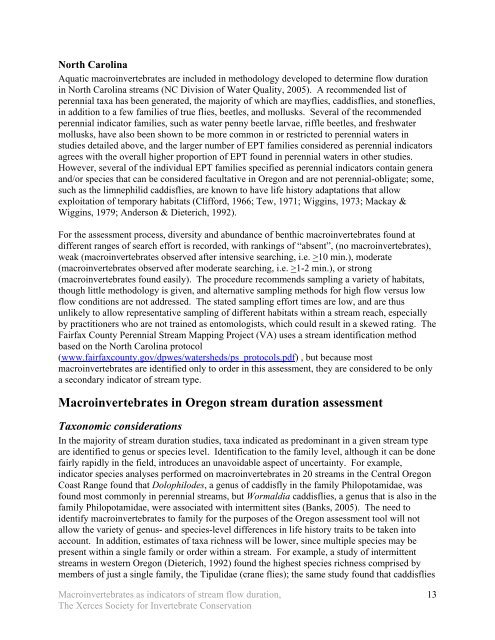Using Aquatic Macroinvertebrates as Indicators of Stream Flow ...
Using Aquatic Macroinvertebrates as Indicators of Stream Flow ...
Using Aquatic Macroinvertebrates as Indicators of Stream Flow ...
Create successful ePaper yourself
Turn your PDF publications into a flip-book with our unique Google optimized e-Paper software.
North Carolina<strong>Aquatic</strong> macroinvertebrates are included in methodology developed to determine flow durationin North Carolina streams (NC Division <strong>of</strong> Water Quality, 2005). A recommended list <strong>of</strong>perennial taxa h<strong>as</strong> been generated, the majority <strong>of</strong> which are mayflies, caddisflies, and stoneflies,in addition to a few families <strong>of</strong> true flies, beetles, and mollusks. Several <strong>of</strong> the recommendedperennial indicator families, such <strong>as</strong> water penny beetle larvae, riffle beetles, and freshwatermollusks, have also been shown to be more common in or restricted to perennial waters instudies detailed above, and the larger number <strong>of</strong> EPT families considered <strong>as</strong> perennial indicatorsagrees with the overall higher proportion <strong>of</strong> EPT found in perennial waters in other studies.However, several <strong>of</strong> the individual EPT families specified <strong>as</strong> perennial indicators contain generaand/or species that can be considered facultative in Oregon and are not perennial-obligate; some,such <strong>as</strong> the limnephilid caddisflies, are known to have life history adaptations that allowexploitation <strong>of</strong> temporary habitats (Clifford, 1966; Tew, 1971; Wiggins, 1973; Mackay &Wiggins, 1979; Anderson & Dieterich, 1992).For the <strong>as</strong>sessment process, diversity and abundance <strong>of</strong> benthic macroinvertebrates found atdifferent ranges <strong>of</strong> search effort is recorded, with rankings <strong>of</strong> “absent”, (no macroinvertebrates),weak (macroinvertebrates observed after intensive searching, i.e. >10 min.), moderate(macroinvertebrates observed after moderate searching, i.e. >1-2 min.), or strong(macroinvertebrates found e<strong>as</strong>ily). The procedure recommends sampling a variety <strong>of</strong> habitats,though little methodology is given, and alternative sampling methods for high flow versus lowflow conditions are not addressed. The stated sampling effort times are low, and are thusunlikely to allow representative sampling <strong>of</strong> different habitats within a stream reach, especiallyby practitioners who are not trained <strong>as</strong> entomologists, which could result in a skewed rating. TheFairfax County Perennial <strong>Stream</strong> Mapping Project (VA) uses a stream identification methodb<strong>as</strong>ed on the North Carolina protocol(www.fairfaxcounty.gov/dpwes/watersheds/ps_protocols.pdf) , but because mostmacroinvertebrates are identified only to order in this <strong>as</strong>sessment, they are considered to be onlya secondary indicator <strong>of</strong> stream type.<strong>Macroinvertebrates</strong> in Oregon stream duration <strong>as</strong>sessmentTaxonomic considerationsIn the majority <strong>of</strong> stream duration studies, taxa indicated <strong>as</strong> predominant in a given stream typeare identified to genus or species level. Identification to the family level, although it can be donefairly rapidly in the field, introduces an unavoidable <strong>as</strong>pect <strong>of</strong> uncertainty. For example,indicator species analyses performed on macroinvertebrates in 20 streams in the Central OregonCo<strong>as</strong>t Range found that Dolophilodes, a genus <strong>of</strong> caddisfly in the family Philopotamidae, w<strong>as</strong>found most commonly in perennial streams, but Wormaldia caddisflies, a genus that is also in thefamily Philopotamidae, were <strong>as</strong>sociated with intermittent sites (Banks, 2005). The need toidentify macroinvertebrates to family for the purposes <strong>of</strong> the Oregon <strong>as</strong>sessment tool will notallow the variety <strong>of</strong> genus- and species-level differences in life history traits to be taken intoaccount. In addition, estimates <strong>of</strong> taxa richness will be lower, since multiple species may bepresent within a single family or order within a stream. For example, a study <strong>of</strong> intermittentstreams in western Oregon (Dieterich, 1992) found the highest species richness comprised bymembers <strong>of</strong> just a single family, the Tipulidae (crane flies); the same study found that caddisflies<strong>Macroinvertebrates</strong> <strong>as</strong> indicators <strong>of</strong> stream flow duration,The Xerces Society for Invertebrate Conservation13
















